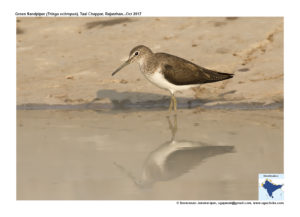Green Sandpiper

Green Sandpiper Tringa ochropus
Etymology:
- Tringa : Greek word for trungasthrush-sized, white-rumped wading bird that bobs its tail, mentioned by Aristotle
- Ochropus : Greek word okhros –pale yellow, ochre; pous –foot
Vernacular Names:
Pun: Hara retalchaha, Guj: Leelitutvari, Leelipagthuthvari, Shwetapunchthuthvari, Mar: Timbla, Hirvituutari, Ta: Aathuchuzhiullan, Te: Nallaulanka, Mal: Kata kokku
Distribution in India:Widespread Winter visitor in India.
Description: Size of 21-24 cm. It is a medium-sized, dark sandpiper; foreneck, breast and upper flanks streaked grey-brown, underparts white; rump white, tail white with thick black bars. It is larger and darker; head greyer, spots on upperparts whiter and more distinct, has white rump visible in flight. The bill is generally heavier and longer, wings broader. The female is similar but larger than the male. The non-breeding adult has less spotted upperparts and face, foreneck and center of breast whiter, and no streaking on flanks.
Habitat: It is found in Damp wooded areas, in old, swampy woodland and montane forest; preferably pine woods, but also in spruce or alder, in vicinity of rivers, streams, swamps or lakes. After breeding found in inland fresh waters, such as marshes, riverbanks, sewage farms, small ponds and narrow ditches, often with protective vegetation.
Food Habits: It eats adult and larval midges, as well as seeds during breeding .In non-breeding season eats insects, small molluscs, crustaceans including crabs, spiders ,annelid worms,small fish ,tadpoles and even frogs; sometimes plant matter like seeds. It pecks at food from shallow water and from surface of ground and plants. It rarely probes. It uses trampling to stir up food like tubifex worms and turns over stones underwater to find leeches. It sometimes wades or swims, and even dives, while feeding. It normally feeds alone, sometimes in small, scattered groups of up to 50 birds.
Breeding Habits: They breed in April- June in Scandinavia and Russia. They are monogamous. The male performs typical Tringa display flight, initially rising on rapidly fluttering or vibrating wings, then describing circular or semi-circular flight, before diving steeply on fixed wings, and then repeating the performance. It uses old tree nests of other bird species, especially thrushes or Common Woodpigeon, usually with little modification, or old squirrel drey; sometimes natural platform, such as stump or mound, occasionally nests on ground, among tree roots, in slight depression with little or no lining.They lay a clutch of 3-4 eggs, with laying interval of 35-43 hours. The incubation period is 20-23 days. Incubation is done by both sexes, mainly by female from last egg.Both sexes tend chicks at first, but female may leave before fledging. The fledging period is 28 days.